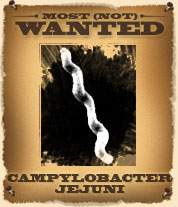
Photo: Dr. Patricia Fields,
Dr. Collette Fitzgerald
(PHIL #5781), 2004
Name
Campylobacter jejuni
Also known as
"Campy"
Description
- spiral-shaped bacterium with a long flagellum (hair-shaped structure used for propulsion) at each end
(Not) Wanted for
causing the most common bacterial gastroenteritis in the world (campylobacteriosis), affecting one of every 200 people in North America alone each year, and about 40% to 60% of children under age five iin developing countries.
Modus operandi
- sneaks unnoticed into its victim through contaminated food or water
- causes diarrhoea (sometimes bloody), abdominal cramping, nausea, and fever within two to five days
- may enter the bloodstream of victims with a weakened immune system, producing a serious and sometimes fatal infection
-
can trick the victim's immune system into attacking its own nerves, causing temporary paralysis (Guillain-Barré syndrome); may cause long-term complications
Most victims are strong enough to evict Campylobacter - usually in about a week - without treatment and to recover completely.
Preferred hideouts
- healthy birds
- avoids open air because of the oxygen in the air
Preferred means of travel
- most frequently raw and undercooked poultry
- also, water and unpasteurized milk.
Associates
- part of a "family" of Campylobacter bacteria
While C. jejuni is the most frequent perpetrator of human illness, close relatives C. coli, C. upsaliensis, and C. lari have also been known to cause campylobacteriosis.
Area of operation
- the entire world
Learn about other pathogens on the Most (Not) Wanted list...
Escherichia coli
Salmonella typhi
Giardia lamblia
Vibrio cholerae


